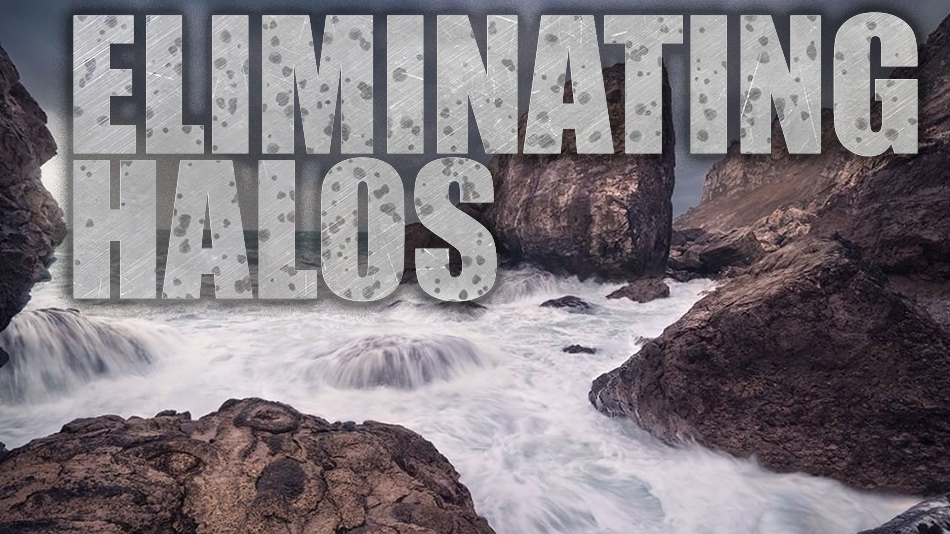Eliminating Halos in Photoshop
This Eliminating Halos in Photoshop Article is by Chris Frost | Landscape photographer of the year 2020. If you would like to write for us, please read here.
Many of us have been there before. After finally finishing the processing of an image, a feeling of satisfaction floods in as you proudly view your finished piece only to notice a small yet unsightly white halo snakingly perfectly around the transition zone between foreground subjects and gloriousgolden hour skies – a distraction that once seen, cannot be unseen.
Whilst these processing halos can be attributed to a number of scenarios, such as over sharpening high contrast areas (trees/rocks against sky areas), over enthusiastic detail recover or as a by-product of HDR packages, it can also be seen when exposure blending slightly misaligned images.Exposure blending allows us to effectively, and with fair ease in most cases, solve cameras’ inherent inability to handle vastly differing levels of light across a scene – particularly for golden hour images where vivid colourful skies are often numerous stops of light brighter than foreground details devoid of direct sunlight. As exposure blending has become more prevalent in recent years, so too has the presence of halos.
Whilst the issue is best addressed at root, often the haloing will only become obviouslyapparent once the image has been processed further with contrast and colour added to the image. This article details the steps required to quickly address this problem and return your images to their intended glory; a task simply achieved with Photoshop’s Clone tool set to Darken mode.
Additionally, and specifically for those sharing my passion for woodland photography, this clone tool trick can also be used to remove those unsightly little areas of sky that always manage to peak though the foliageno matter how hard you try to negate them when composing the image. The second part of this article details how to handle these often-unavoidable annoyances.
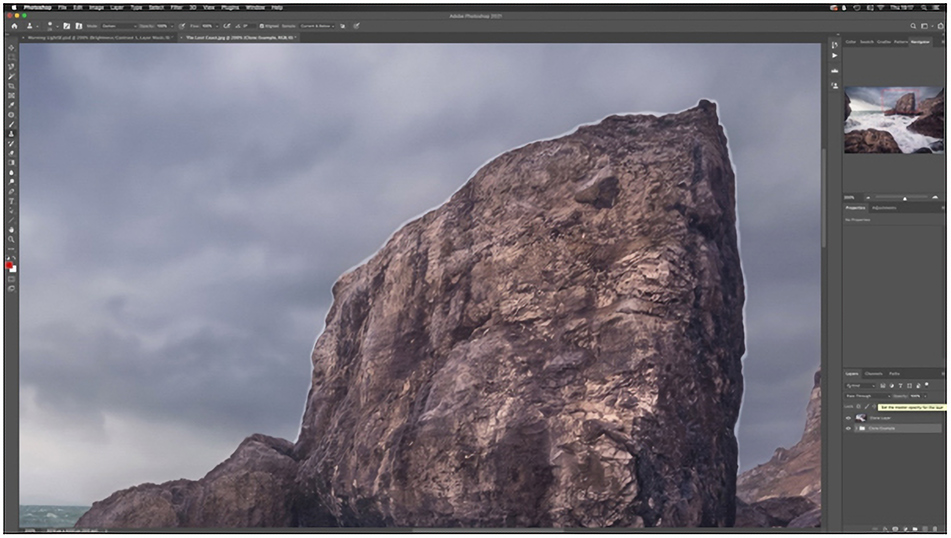
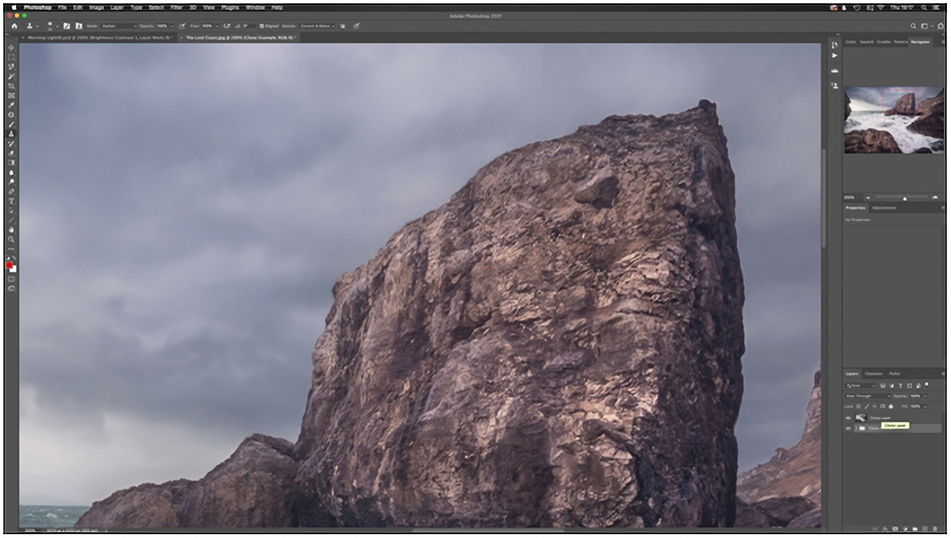
-Tutorial Continued Below-
Prepping The Image For Removing Halos in Photoshop
Before commencing the clone work, a pixel layer will need to be created which will be used for the selection of replacement pixels and any cloning undertaken.
1. On a Mac, hitting Command-Option-Shift-E (for Windows use Shift-Ctrl-Alt-E) will create a stamp visible layer on top of the stack ready for the cloning work.Always ensure that this is selected as the Active layer.
 |
An important point to note. The layer opacity should be set to 100%. Having this at a lower opacity will result in any cloned changes only being partially visible which may lead to undesirable ghosting effects. |
2. For ease of reference, rename the new Clone layer with a suitable description.
3. From the Photoshop Toolbar, choose the Clone Stamptool.
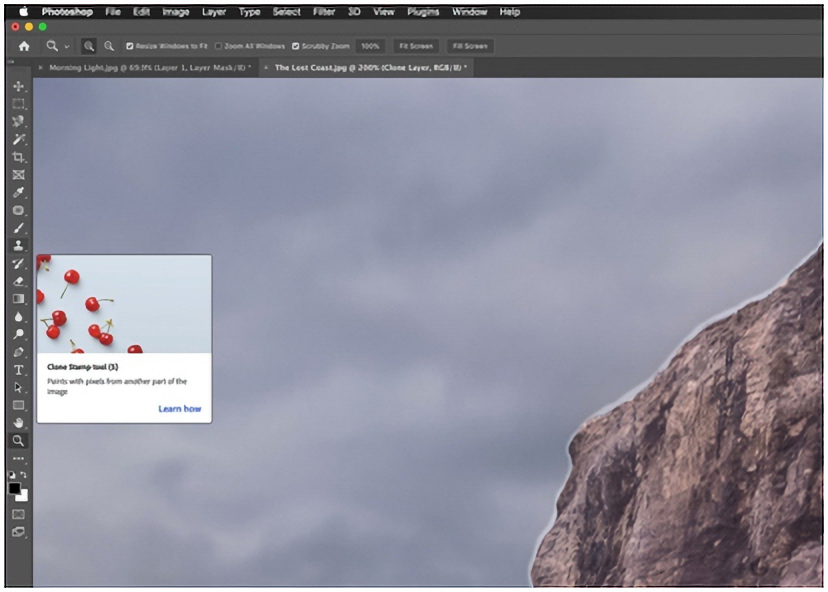
4. Change the Mode to Darken and ensuring that the Aligned box is also checked.Setting the blend mode to Darken changes the way in which Photoshop allows Clone Stamp corrections to be drawn in. InDarkenMode, Photoshop will only allow changes to areas where tones are lighter than those from the sampled source area. Therefore, the darker areas of the sky from around the sample point and the darker horizon area (rocks/trees) will remain untouched whilst only the lighter halo area will be affected by the Clone tool corrections.
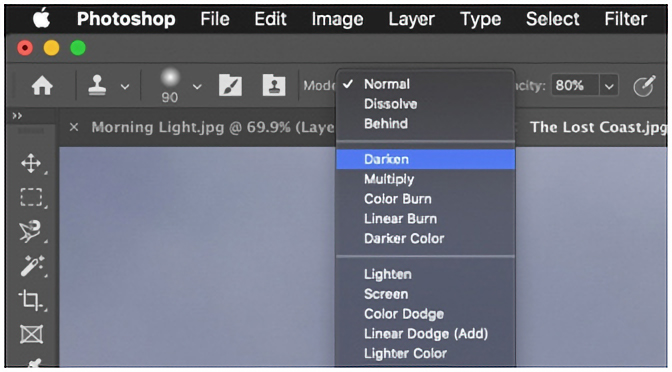
5. Change theSampleoption to Current Layer and Below.

6. The next step is personal preference. For those preferring to make the changes in one fell swoop, set the Opacity to 100%; those wishing to build up the effect/corrections more gradually should choose an Opacity around 50-70%.

7. Finally, set the brush hardness to a low value;a valueunder25% works well and allows for easy control of the corrections being draw in – this will instruct Photoshop to clone with a soft edged brush. Using a higher hardness value can lead to transitions beingless smooth.
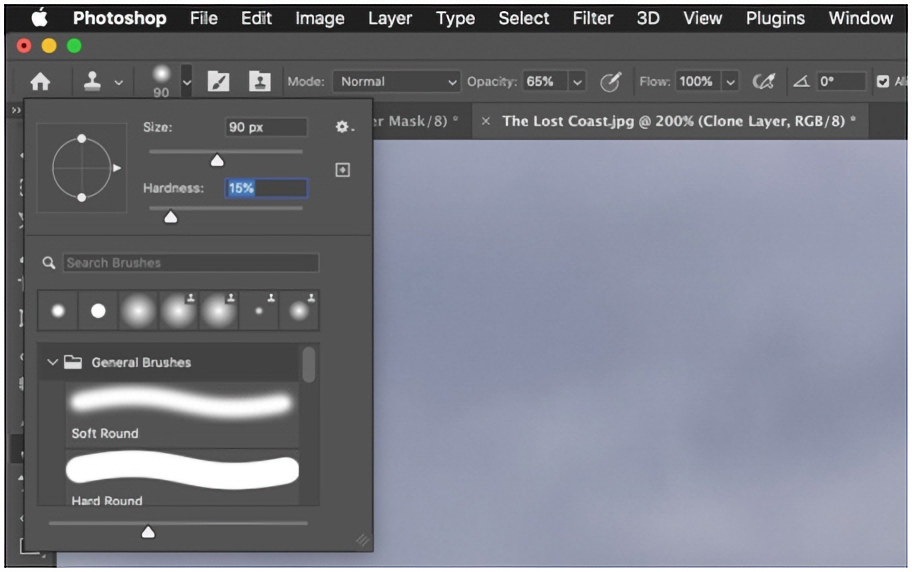
Correcting the Halo – Eliminating Halos in Photoshop
1. We’re now ready to correct the halo. Using the Clone tool, depress the Option key (Alt for Windows users) and left click to select the area you wish to source pixels from; this should be located close to the halo area and be made up of colours and tones that will blend seamlessly with the destination location.
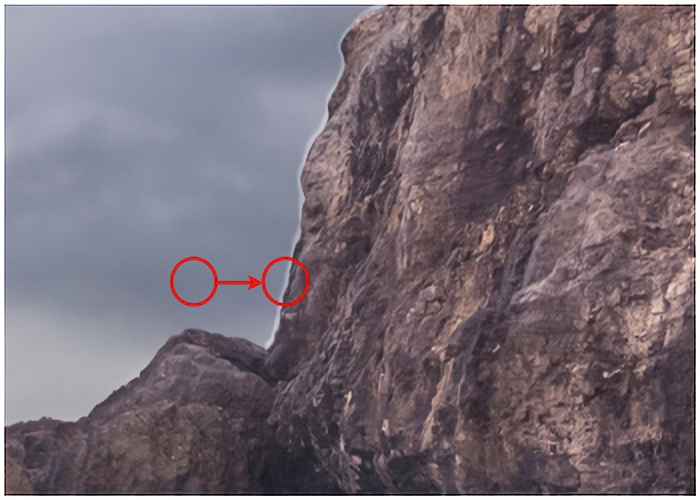
2. Once happy with the source selection, start brushing over the destination area with the clone stamp, replacing the light halo pixels with those from the source area and building up the effect so that the halo is removed with a seamless transition.When correcting a horizon line, simply choose a source above and in close proximity to the halo line, before painting across the whole halo. Photoshop will move the source pixels in relation to the destination so any change in pixel tone, colour or content should be reflected as you paint across the halo area. For more complex halos, resample the source data frequently; this will allow for a more natural and believable correction.
3. With DarkenMode selected, Photoshop will only allow corrections to areas where tones are lighter than those from the sampled source area – this should protect foreground details from being impacted by the clone activities.
4. In most cases, the steps detailed above will deliver clean and easily achievable results. However, there will be scenarios where a little extra effort is required to complete the process. There may be instances where the corrected sky has uneven patches which can be easily corrected, resampling moresuitable source areas before re-cloning over the problem areas. In the rare instances where the clone corrections have bled over into the foreground, these can be quickly masked out by adding a Mask to the Clone layer and painting over problem areas on that mask with a black brush.
Correcting ‘Dark’ Halos – Eliminating Halos in Photoshop
Whilst light halos are more commonly seen, there will be exposure blending faux pas where foreground elements, such as rocks, may exhibit a darker ring around their outer edges – typically, a result of the blend allowing too much of the darker sky expose to bleed into the foreground exposure. Correcting these instances should be no different than for the sky, with one small change in the processing steps detailed previously. Rather than changing the Clone StampMode to Darken (step 4), in this instance the Mode should be changed to Lighten.
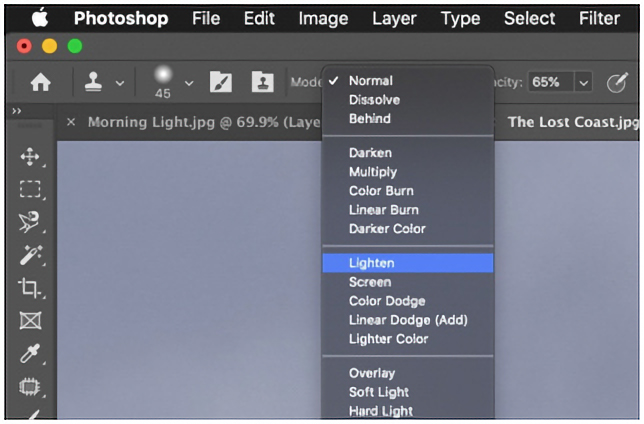
Changing the blend mode to Lighten changes the way in which Photoshop allows Clone Stamp corrections to be drawn in. With Lighten selected, Photoshop will only allow changes to areas where tones are darker than those from the sampled source area. Therefore, the lighter areas of the sky will remain untouched whilst the dark halo area of the rock iscorrected. This correction can be achieved by sampling from correctly exposed areas of the rock/foreground tothen cloning over the dark halo areas.
Woodland Tidy – Eliminating Halos in Photoshop
The same principles apply when working with woodland imagery, but the application will be slightly different. In some cases, specular highlights bursting through the canopy will add to the atmosphere and feel of an image but there may be instances where little gaps in the canopy detract from the overall image, distracting the eye from key elements. Cloning foliage into these bright areas can reduce distractions and help develop a feeling of containment, of being completely enclosed by the woodland.
Steps 1 to 7remain the same as detailed in the Halo section above.
1. From there, rather than choosing source pixels in close proximity, choose from an area having similar foliage colour, luminosity and coverage for the area to be corrected. Where possible, look to avoid areas that contain branches and tree trunks; cloning branches into the sky areas will look awkward and unnatural unless they are subtly blended into existing trees.
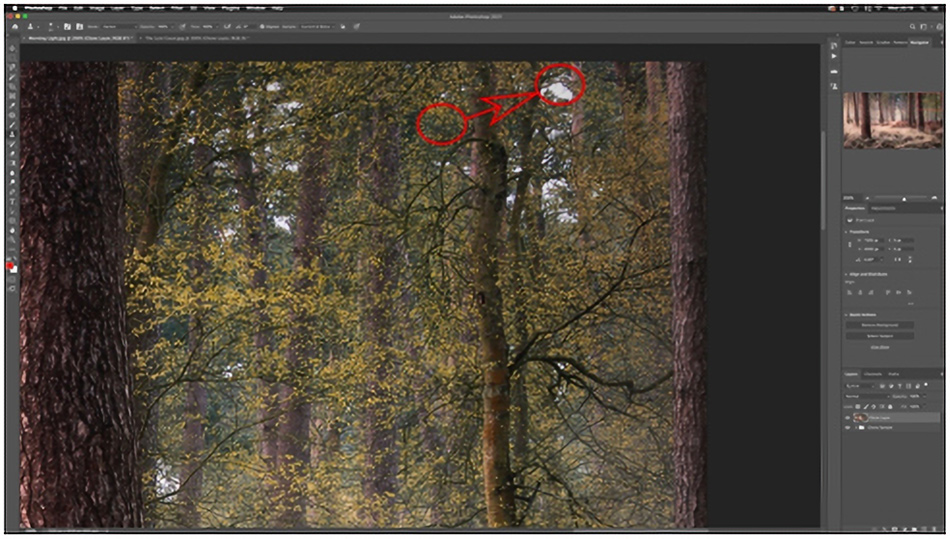
2. Once happy with the source selection, change the brush Opacityto 100% and start brushing over the destination area filling the sky areas with the chosen leaf selection. Selecting an Opacity of 100% will avoid any semi cloned areas that will leave ghosting issues.For larger areas, it is often advisable to resample the source data frequently which will allow for a more natural and believable correction.
3. Again, use of the Darken mode will restrict the painting in of the chosen foliage to areas of lightness – in this case the exposed sky. This should protect the tree details around that area from being impacted by the clone activities.
4. In most cases, the steps detailed above will deliver clean and easily achievable results; however, there will be scenarios where a little extra effort is required to complete the process. There may be some instances where the corrections spill over into adjacent tree trunks leaving ghostly leaf shapes – this can be easily corrected. Simply resamplean area of the tree trunk in close proximity, before cloning over the problem area(s) ensuring that the cloned in tree trunk edge is aligned with the original image. Alternatively, add a mask to the layer and using the Brush tool set to black, paint over the area of concern to mask the unwanted changes out.
A very simple process, but one that is effective and easy to use and can quickly save an image, or in the case of woodland images, remove unwanted distractions and add to the images impact.
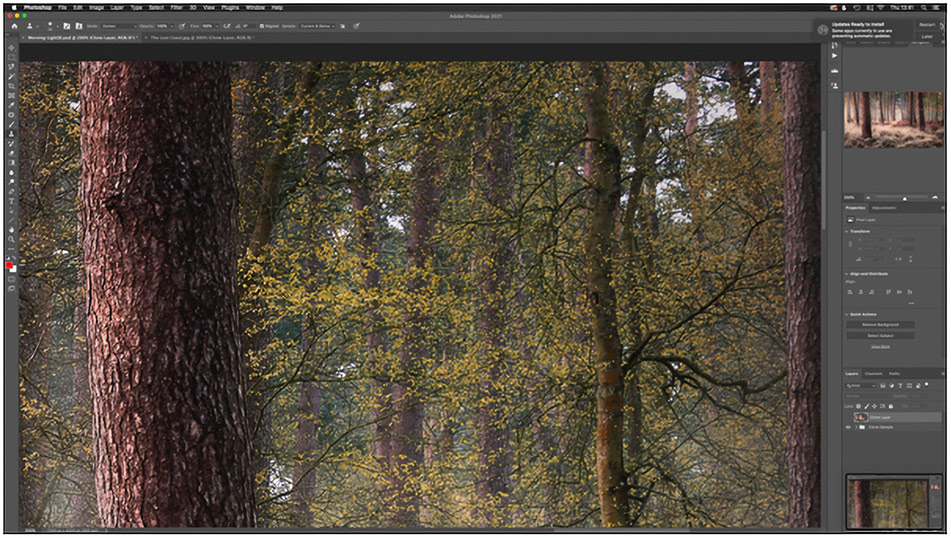
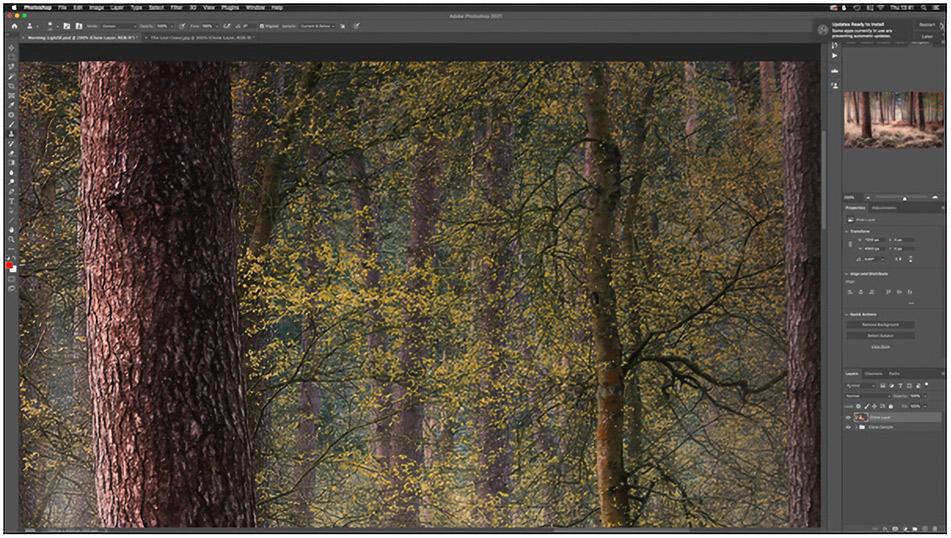
Images from Chris Frost | Landscape photographer of the year 2020
Writers Accolades – Chris Frost
Awards:
– Winner – UK Landscape Photographer of the Year 2020 –Woolland Woods
– Winner – Snapping a Twig (Woodland Trust photo competition) 2020 – Fallen
